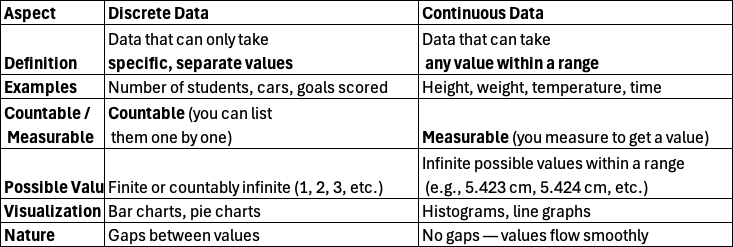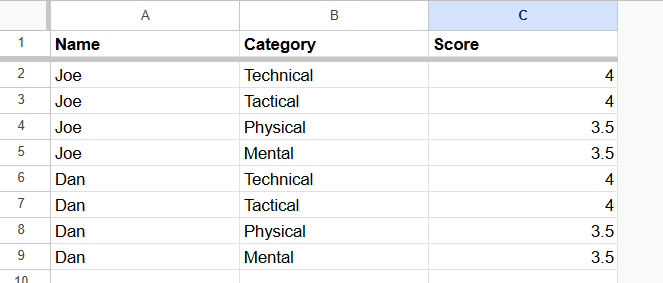AI - Types of Data
1. Structured Data • Everything is organized into fixed fields (like a spreadsheet). • Easy for computers to read and search. • Stored usually in relational databases (SQL). Examples: • Bank transactions (Date, Amount, Payee) • Student grades (Name, Subject, Score) ⸻ 2. Unstructured Data • No fixed format or organization. • Hard for machines to search directly — needs special tools (like NLP or Computer Vision). • Makes up ~80% of all data in the world! Examples: • A video recording (no obvious fields) • A random tweet or Instagram post • An image from a security camera ⸻ 3. Semi-Structured Data • Partly organized — has some tags, keys, or structure, but not as rigid as a table. • Flexible format — easier to manage than unstructured data, but not fully structured. Examples: • JSON from an API, XML documents Structured, Unstructured, and Semi-structured Data Discrete v/s Continuous Data Measurement Scales for Data

1. Structured Data
• Everything is organized into fixed fields (like a spreadsheet).
• Easy for computers to read and search.
• Stored usually in relational databases (SQL).
Examples:
• Bank transactions (Date, Amount, Payee)
• Student grades (Name, Subject, Score)
⸻
2. Unstructured Data
• No fixed format or organization.
• Hard for machines to search directly — needs special tools (like NLP or Computer Vision).
• Makes up ~80% of all data in the world!
Examples:
• A video recording (no obvious fields)
• A random tweet or Instagram post
• An image from a security camera
⸻
3. Semi-Structured Data
• Partly organized — has some tags, keys, or structure, but not as rigid as a table.
• Flexible format — easier to manage than unstructured data, but not fully structured.
Examples:
• JSON from an API, XML documents
Structured, Unstructured, and Semi-structured Data
Discrete v/s Continuous Data
Measurement Scales for Data
































































































































































![[The AI Show Episode 143]: ChatGPT Revenue Surge, New AGI Timelines, Amazon’s AI Agent, Claude for Education, Model Context Protocol & LLMs Pass the Turing Test](https://www.marketingaiinstitute.com/hubfs/ep%20143%20cover.png)






























































































































![[DEALS] Koofr Cloud Storage: Lifetime Subscription (1TB) (80% off) & Other Deals Up To 98% Off – Offers End Soon!](https://www.javacodegeeks.com/wp-content/uploads/2012/12/jcg-logo.jpg)
























![Is this too much for a modular monolith system? [closed]](https://i.sstatic.net/pYL1nsfg.png)




















































































































_roibu_Alamy.jpg?width=1280&auto=webp&quality=80&disable=upscale#)




 CISO’s Core Focus.webp?#)






































































































![M4 MacBook Air Drops to Just $849 - Act Fast! [Lowest Price Ever]](https://www.iclarified.com/images/news/97140/97140/97140-640.jpg)
![Apple Smart Glasses Not Close to Being Ready as Meta Targets 2025 [Gurman]](https://www.iclarified.com/images/news/97139/97139/97139-640.jpg)
![iPadOS 19 May Introduce Menu Bar, iOS 19 to Support External Displays [Rumor]](https://www.iclarified.com/images/news/97137/97137/97137-640.jpg)









































































































